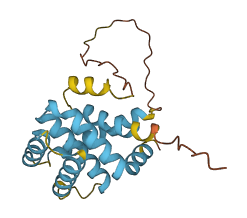| activation of cysteine-type endopeptidase activity involved in apoptotic process |
Any process that initiates the activity of the inactive enzyme cysteine-type endopeptidase in the context of an apoptotic process. |
| apoptotic mitochondrial changes |
The morphological and physiological alterations undergone by mitochondria during apoptosis. |
| establishment of protein localization to membrane |
The directed movement of a protein to a specific location in a membrane. |
| extrinsic apoptotic signaling pathway |
The series of molecular signals in which a signal is conveyed from the cell surface to trigger the apoptotic death of a cell. The pathway starts with either a ligand binding to a cell surface receptor, or a ligand being withdrawn from a cell surface receptor (e.g. in the case of signaling by dependence receptors), and ends when the execution phase of apoptosis is triggered. |
| hepatocyte apoptotic process |
Any apoptotic process in a hepatocyte, the main structural component of the liver. |
| mitochondrial ATP synthesis coupled electron transport |
The transfer of electrons through a series of electron donors and acceptors, generating energy that is ultimately used for synthesis of ATP, as it occurs in the mitochondrial inner membrane or chloroplast thylakoid membrane. |
| mitochondrial outer membrane permeabilization |
The process by which the mitochondrial outer membrane becomes permeable to the passing of proteins and other molecules from the intermembrane space to the cytosol as part of the apoptotic signaling pathway. |
| negative regulation of intrinsic apoptotic signaling pathway in response to DNA damage |
Any process that stops, prevents or reduces the frequency, rate or extent of intrinsic apoptotic signaling pathway in response to DNA damage. |
| positive regulation of apoptotic process |
Any process that activates or increases the frequency, rate or extent of cell death by apoptotic process. |
| positive regulation of apoptotic signaling pathway |
Any process that activates or increases the frequency, rate or extent of apoptotic signaling pathway. |
| positive regulation of autophagy in response to ER overload |
The process in which the accumulation of misfolded proteins in the endoplasmic reticulum triggers a response that positively regulates autophagy. |
| positive regulation of extrinsic apoptotic signaling pathway |
Any process that activates or increases the frequency, rate or extent of extrinsic apoptotic signaling pathway. |
| positive regulation of fibroblast apoptotic process |
Any process that activates or increases the frequency, rate or extent of fibroblast apoptotic process. |
| positive regulation of intrinsic apoptotic signaling pathway |
Any process that activates or increases the frequency, rate or extent of intrinsic apoptotic signaling pathway. |
| positive regulation of mitochondrial membrane potential |
Any process that activates or increases the frequency, rate or extent of establishment or extent of a mitochondrial membrane potential, the electric potential existing across any mitochondrial membrane arising from charges in the membrane itself and from the charges present in the media on either side of the membrane. |
| positive regulation of protein-containing complex assembly |
Any process that activates or increases the frequency, rate or extent of protein complex assembly. |
| positive regulation of release of cytochrome c from mitochondria |
Any process that increases the rate, frequency or extent of release of cytochrome c from mitochondria, the process in which cytochrome c is enabled to move from the mitochondrial intermembrane space into the cytosol, which is an early step in apoptosis and leads to caspase activation. |
| protein targeting to mitochondrion |
The process of directing proteins towards and into the mitochondrion, usually mediated by mitochondrial proteins that recognize signals contained within the imported protein. |
| protein-containing complex assembly |
The aggregation, arrangement and bonding together of a set of macromolecules to form a protein-containing complex. |
| regulation of apoptotic process |
Any process that modulates the occurrence or rate of cell death by apoptotic process. |
| regulation of epithelial cell proliferation |
Any process that modulates the frequency, rate or extent of epithelial cell proliferation. |
| regulation of G1/S transition of mitotic cell cycle |
Any signalling pathway that modulates the activity of a cell cycle cyclin-dependent protein kinase to modulate the switch from G1 phase to S phase of the mitotic cell cycle. |
| regulation of mitochondrial membrane permeability involved in apoptotic process |
Any regulation of mitochondrial membrane permeability that is involved in apoptotic process. |
| regulation of T cell proliferation |
Any process that modulates the frequency, rate or extent of T cell proliferation. |
| release of cytochrome c from mitochondria |
The process that results in the movement of cytochrome c from the mitochondrial intermembrane space into the cytosol, which is part of the apoptotic signaling pathway and leads to caspase activation. |
| signal transduction in response to DNA damage |
A cascade of processes induced by the detection of DNA damage within a cell. |
| supramolecular fiber organization |
A process that is carried out at the cellular level which results in the assembly, arrangement of constituent parts, or disassembly of a supramolecular fiber, a polymer consisting of an indefinite number of protein or protein complex subunits that have polymerised to form a fiber-shaped structure. |


